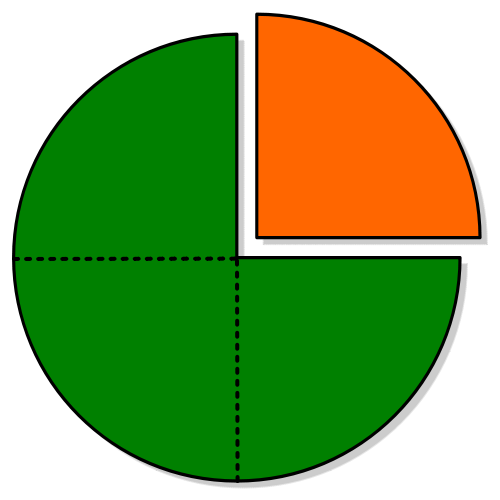Ordering, Adding, & Subtracting Fractions: Methods and Examples
Lesson Overview
- Why Are Fractions Significant?
- How Do You Convert Fractions Between Improper and Mixed Forms?
- What Strategies Determine Fraction Order?
- Why Is Recognizing Fraction Equivalency Important?
- How Can You Add Fractions?
- What Techniques Ensure Precise Fraction Subtraction?
- How Do Common Mistakes Occur in Fraction Operations?
- How Can Fraction Operations Be Applied to Practical Scenarios?
- Comprehensive Practice Problems
Imagine you are managing a school event and need to carefully measure decorations and refreshments. Ordering, Adding, & Subtracting Fractions becomes critical to avoid shortages or waste. This lesson addresses such practical challenges by thoroughly explaining fraction operations, empowering you to handle everyday and academic situations with ease and precision.
Why Are Fractions Significant?
This section explains why fractions are indispensable in practical scenarios. Fractions are everywhere-from recipes and construction measurements to finance and science. Mastering fractions allows precise calculation and measurement, essential for real-world success and efficiency.
How Do You Convert Fractions Between Improper and Mixed Forms?
This segment provides a detailed approach to converting improper fractions and mixed numbers, which is crucial for clarity in mathematical operations.
Converting Improper Fractions to Mixed Numbers
The process is simple yet essential:
- Divide the numerator by the denominator.
- Write the quotient as a whole number.
- Place the remainder over the original denominator.
Example:
- Convert 11/3: 11 ÷ 3 = 3 remainder 2, resulting in 3 2/3.
Converting Mixed Numbers to Improper Fractions
Steps for clarity and accuracy:
- Multiply the whole number by the denominator.
- Add the numerator to the product.
- Write the total over the original denominator.
Example:
- Convert 4 2/5: (4 × 5) + 2 = 22/5.
What Strategies Determine Fraction Order?
This detailed exploration covers the precise methodology to order fractions effectively.
Steps for Ordering Fractions:
- Determine the least common denominator (LCD).
- Convert fractions to equivalent forms using the LCD.
- Compare numerators directly to sequence fractions.
Example:
- Arrange 2/3, 5/6, and 1/2:
- LCD = 6, fractions become 4/6, 5/6, and 3/6, thus ordered: 1/2, 2/3, 5/6.
Why Is Recognizing Fraction Equivalency Important?
Understanding equivalent fractions is critical for accurate mathematical operations and comparisons.
Identifying Equivalent Fractions
- Multiply or divide the numerator and denominator by the same number.
- Confirm that ratios match across fractions.
Example:
- Confirm that 3/4 equals 6/8, 9/12, not equivalent to 3/5.
How Can You Add Fractions?
This section delves deeply into precise methods of adding fractions, essential for accurate computations.
Adding Fractions with Common Denominators
- Simply add numerators while keeping denominators constant.
Example:
- 1/3 + 1/3 = 2/3.
Adding Fractions with Different Denominators
- Find the least common denominator (LCD).
- Convert fractions and sum numerators.
Example:
- 2/5 + 1/10, LCD = 10:
- Convert 2/5 to 4/10, add to get 5/10 = 1/2.
Adding Mixed Numbers
- Separately sum whole numbers and fractional parts.
Example:
- Add 3 1/4 and 2 2/3, LCD = 12:
- Whole numbers: 3 + 2 = 5, fractions: 3/12 + 8/12 = 11/12, total = 5 11/12.
What Techniques Ensure Precise Fraction Subtraction?
Fraction subtraction requires the careful execution of precise methodologies.
Subtracting Fractions with Common Denominators
- Subtract numerators directly.
Example:
- 3/5 - 1/5 = 2/5.
Subtracting Fractions with Different Denominators
- Determine LCD, convert fractions, and subtract numerators.
Example:
- 3/4 - 1/8, LCD = 8:
- Convert 3/4 to 6/8, subtract to get 5/8.
Take This Quiz!
How Do Common Mistakes Occur in Fraction Operations?
Identifying common mistakes helps prevent errors in fraction operations:
- Failing to simplify fractions.
- Miscalculating the LCD.
- Misreading fractional notation.
Avoiding these errors ensures accuracy and efficiency in fraction computations.
How Can Fraction Operations Be Applied to Practical Scenarios?
Fractions apply in everyday scenarios:
- Cooking precise recipes.
- Planning resource usage.
- Calculating financial transactions.
Real-world Example:
- If a container holds 5 3/4 liters and you pour out 2 1/2 liters, how much remains?
Comprehensive Practice Problems
Regular practice ensures mastery.
- Convert 18/7 into a mixed number:
Step 1: 18 ÷ 7 = 2 remainder 4
Step 2: Mixed number = 2 4/7
Answer:
18/7 = 2 4/7
- Add 3/8 and 1/4:
Step 1: Find common denominator = 8
Step 2: 3/8 + 2/8 = 5/8
Answer:
3/8 + 1/4 = 5/8
- Subtract 7/9 from 5/6:
Step 1: Common denominator = 18
Step 2: 15/18 − 14/18 = 1/18
Answer:
5/6 − 7/9 = 1/18
- Order 1/3, 4/9, and 2/6 from least to greatest:
Step 1: Common denominator = 18
Step 2: 6/18, 8/18, 6/18
Step 3: Order = 6/18, 6/18, 8/18 (1/3, 2/6, 4/9)
Answer:
1/3, 2/6, 4/9
Take This Quiz!
Rate this lesson:
 Back to top
Back to top
(101).jpg)
